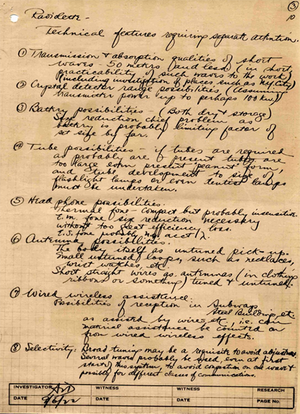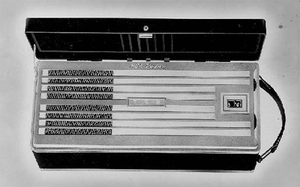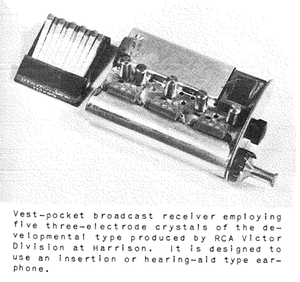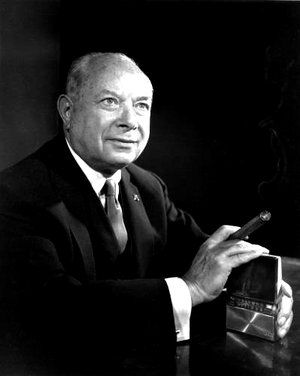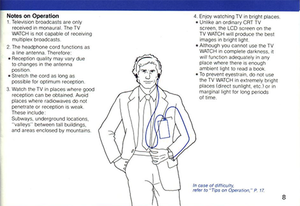Wrist-Wearable Electronics
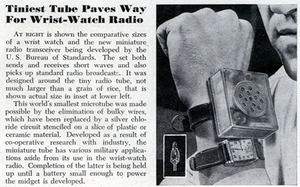
With the debut of Samsung’s smart watch in September of 2013 and speculation about Apple’s applications for an iWatch trademark in the summer of 2012, some writers have traced the concept of wireless wrist devices to Chester Gould. The creator of the Dick Tracy comic strip, Gould put a wrist radio on his police detective in 1946. Gould was allegedly inspired by a visit to the lab of Albert Gross, who pioneered the commercialization of miniature radio pagers in the late 1940s. Gould’s archives show no record, however, of meeting Gross or of stopping in Ohio, where Gross ran his company, during his railroad commutes between Chicago and New York. In a memoir Gould failed to relate the source of his inspiration in a career retrospective. Instead he explained only that he kept highlighting it with a box and arrow because he wanted the reader “to remember that when the first two-way wrist radio comes into reality. . . he saw the first one in Dick Tracy.” (“Dick Tracy and I,” in Bill Crouch, Jr.’s Dick Tracy: America’s Most Famous Detective, p. 40)
Where, then, did Gould get his inspiration, and was he the first person to imagine such a device? The answer is rather complicated but worth exploring as a reminder of the long and winding roads by which an idea reaches the market. Between an original concept sketched for a comic or scribbled on a napkin, and a common object of desire or need, inventions and their backers face a variety of technological, commercial, and consumer obstacles, as well as opportunities.
On Wednesday, 2 August 1922, David Sarnoff, the general manager of the Radio Corporation of America (RCA), wrote to Dr. Alfred Goldsmith, director of the young company’s small Research Department facing Van Cortland Park in New York City. Interested in reviving radio sales during the summer and following up on his success in the expansion of the radio industry to the home, Sarnoff observed that the “third stage of radio. . . be extended. . . to the individual, whether he be within or outside of a fixed place.” Sarnoff was undoubtedly aware of portable crystal radio sets and wireless telephones, but he suggested that RCA “take advantage of recent technical improvements in shortwave communication” to set up a broadcast system with a transmitter “operating on extremely short waves--say, somewhere between 5 and 25 meters” (60 to 12 MHz) at RCA’s Aeolian Hall station. This could transmit “baseball scores, stock quotations, news items (perhaps in headline form), weather reports, railroad schedules or changes thereto. . . and a variety of items too numerous to mention . . . .”
Sarnoff recognized that the primary technical problem in this system was “developing a suitable receiver in such compact and efficient form as to enable an individual to conveniently carry it on his or her person. . . . The ideal . . . is the watch carried by a lady or a gentleman, which is not only serviceable but ornamental as well.” He called this device a Radiolette for “the want of a better name,” the suffix indicating the smaller size of the device. The Radiolette would, “in its first models,” use the best dry-cell batteries and electron tubes in RCA’s superregenerative circuit to receive signals up to 25 miles away. Anticipating the critiques of today’s wrist phones, Sarnoff understood that esthetics should complement utility, and so the new product “should be beautiful.” Finally, given that “development is sure to be directed toward making the Radiolette smaller and smaller,” he foresaw that eventually it would be made in watch form, “and this would introduce the element of jewelry. It is not inconceivable that diamond-studded Radiolettes, mounted in platinum, will be the most hoped-for gift of the society lady. . . .”
The average consumer was not overlooked in Sarnoff’s disquisition. Thus, with the vision of a radio for every individual in RCA’s grasp, the GM and chairman of RCA’s Technical Committee concluded by asking his technical director, “When may I expect the first sample Radiolette?”
Goldsmith had known Sarnoff at least since 1914 when the younger man became secretary for the new Institute of Radio Engineers—one of IEEE’s predecessors—that Goldsmith helped organize two years before. In 1920 he led the design of RCA’s Radiola prototype under Sarnoff’s urging. This time he took over five weeks to respond, busy preparing patents for radios that could fit in a Victrola record player in accord with another initiative by Sarnoff. The Radiolette was a long-term project, Goldsmith made clear in his response, that “in a preliminary form, can be produced today,” if Sarnoff was “willing to pay for it” and add to the five-man research staff. Goldsmith warned of the “serious engineering difficulties” involved in shrinking all components, from antenna to battery to “the amazingly small dimensions and weight. . . required for a ‘Radiolette.’” The wrist radio would have to wait on “the necessary revolution in the vacuum tube manufacturing methods which would be required,” along with the innovations necessary to reduce passive electronic components to watch scale.
Before responding to Sarnoff’s question, Goldsmith had already assigned the preliminary investigation of a “radio garment” to Arthur Van Dyck, whom he met with on 5 September. This “intermediate” approach to portability required concealing all components within an overcoat. Van Dyck, who had joined the staff 1 September from General Electric Company’s Radio Department, thought that Sarnoff and Goldsmith’s “personal radio” in “wrist watch form”was a fantasy that “will be realized in the future in the form which we can today barely visualize with present means.” Nonetheless he noted the demand for a decorative appearance, with Goldsmith’s loop antenna disguised as a woman’s necklace. The next day he outlined eight technical issues to be addressed including batteries, the “limiting factor of set size by far;” electron tubes, which needed reduction to the “size of flashlight lamps or even dentist lamps;” headphones; propagation in New York City; and “Wired wireless assistance” or improving short wave transmission in buildings or the subways through additional antennas.
A meeting a week later put an end to work on Sarnoff’s Radiolette, which had to wait for engineers and scientists to resolve the issues Van Dyck spelled out. Staff at RCA did not forget Sarnoff’s request, however. By the late 1930s miniaturization of batteries and tubes made a “personal” pocket radio possible, if that pocket was in an overcoat. Engineers and designers crammed AM radio circuitry, and four mini tubes into a brick-sized box encased in black leatherette and chrome-plated trim. Despite dealer surveys that overwhelmingly rejected the odd-looking portable that cost more than equivalent home models, RCA marketed it in the New York metropolitan area as an attractive novelty that celebrities were happy to promote. The company expanded its marketing and production, selling over 225,000 BP-10s in six months while RCA licensees joined in by designing their own variants.
Sarnoff and RCA focused on broadcast receivers, however; others shrank the size of transceivers. In 1938 20-year-old Al Gross built his own handheld transceiver at Case School of Applied Science; the ham radio network brought his work to the attention of the Office of Strategic Services (OSS) several years later. Gross helped miniaturize and manufacture the ground-to-air transceivers of the Joan-Eleanor system used for spies operating in Nazi Europe and Japanese-occupied China in 1944-45. At about the same time, in 1940, Donald Mitchell at Galvin Manufacturing Corporation began developing a handheld AM transceiver that the U.S. Army Signal Corps rejected until President Franklin Roosevelt noticed one of his Secret Service guards using one on election day. Over the next twelve months, the newly christened SCR536 “Handie Talkie” went into production for use by the Army’s new paratrooper platoon.
Inspired by publicity about Motorola’s portable transceivers as the war ended, Gould first sketched a two-way wrist radio and television in mid-October 1945. At that time RCA, Philco, and other companies were only beginning to promote, not sell, television receivers in the chaotic and regulated postwar economy. Gould omitted the TV when he introduced his new crime-fighting technology in the Sunday comic on 16 January 1946.
The first depiction of the wrist radio occurred in a murder mystery involving the billionaire industrialist Diet Smith and attempted theft of his son Brilliant’s latest invention. Tracy’s hillbilly associate B. O. Plenty found one of the first five two-way miniature devices outside Smith's mansion. Tracy proclaims it “miraculous” as Gould depicts its insides twice in two days: two tiny vacuum tubes, a tiny battery, a microphone, and a loudspeaker. Smith, upset at the invention’s exposure, exclaims that the wrist radio was “our top secret! It was still in the research stage!” Smith kept it out of production because Tracy’s police partner Sam Catchem was the only other user, starting in 1949. What powered such a radio? Gilbert Newton calculated the electrode potential of lithium in 1913, and Gould was the next to promote use of lithium as a compact energy source by making it a component of the wrist radio’s battery. Eight years later, inspired by Sarnoff’s promotion of RCA’s latest invention earlier in 1954, Gould revealed that the power source was actually an atomic battery.
Promotion of Tracy’s wrist radio spread beyond the comic. Ralph Byrd, the star of Dick Tracy short movies before World War II, wore one made made with a bulky telephone receiver cap in two Dick Tracy movies in 1947. Several companies made and marketed toy versions of the wrist radio in the 1950s and 1960s. These included crystal sets, transistorized receivers powered by mercury batteries, and transistorized two-way sets that put the transceiver pack on a boy’s belt.
At the same time other people tried to make the wrist radio a reality. Gould’s conception inspired Cledo Brunetti to start work at the National Bureau of Standards, which demonstrated its boxy wrist radio transceiver in October 1947, along with the grain-sized electron tube and printed circuit board that made it possible. Gross, having made and sold 100,000 portable citizen’s band radios on the new postwar FCC channels, worked on his W-1 wrist radio at his lab in 1949-50. Yet that was as far as he got. His miniature two-way radio pager for doctors failed to gain acceptance beyond experimental use at New York’s Jewish Memorial Hospital in the early 1950s.
RCA Laboratories never went that far but in the fall of 1948, following up on Bell Labs’ June announcement of the transistor, engineers Wendell Carlson and Loy Barton showed off internally a shirt-pocket broadcast receiver that output the signal to an ear bud or phone. Despite considerable work at the RCA Labs and Tube Division on improving transistors, their manufacture, and their application to consumer electronics, the RCA Victor Home Instruments Division demurred on commercialization. Even Sarnoff’s wish could not override the economic risks when the company was struggling with the costs of color television.
RCA’s tardiness with transistor radios did not deter Sarnoff from updating his vision of a personal, portable information device. In 1960 he was photographed for a promotion on TVs of the 1970s with a handheld AM/FM radio and color TV receiver model; the display demonstrated his desire for a flat-panel display to supplant the cathode-ray tubes on which television sets depended. At the National Press Club in 1961 Sarnoff showed off the model again to highlight the goal of enabling “direct man-to-man sight-and-sound communications over the ultimate distances.” He predicted that the attending reporters would eventually see radio-video transceivers one third the size of what he held, on which they and their editors could communicate on encrypted, digital, audio and video frequencies. Three years later, writing in Fortune, Sarnoff foresaw that by 2000, people would interact “with anyone, anywhere, at any time by voice, sight or written message. . . . using personal channels similar to today’s telephone numbers.”
Sarnoff lived long enough to see RCA introduce low-power CMOS integrated circuits and liquid crystal displays by the end of 1970, but not long enough to see RCA broken up by General Electric. Gould and his successor Max Collins continued to imagine ever higher-capacity wrist-based technologies. In 1964 Diet Smith gave Tracy and Sam Catchem two-way wrist televisions, complete with camera, picture tube, and atomic power that also provided a powerful light. Eighteen years later, Seiko sold the first wrist television, which, like the kids’ wrist radio transceiver, required a belt pack to hold the transmitter and receiver.
After Collins succeeded Gould as the strip’s writer, he and artist Dick Locher updated Tracy to a cell-networked wrist computer in 1986 that could access fingerprint, license plate, and firearms registration databases. Its LCD color screen offered four lines of data or two-way video as well as a display for chemical analyses, lie detection, and the time of day. To top it off, Collins ensured unique access to these tools not by the fingerprints that have their own drawbacks as a biometric substitute for passwords, but through heartbeat identification. A generation later, the technologies, manufacturing capability, and marketing are all in place to offer the general public what only Sarnoff could imagine or Dick Tracy could obtain. The unanswered question is whether enough customers will find a wrist-based computer/TV/radio ergonomically or practically useful.
Further Reading
“About the SCR-300,” in H. S. Magnuski, Radio Set SCR-300-A War Department Technical Manual TM 11-242, visited 20 September 2013.
“Al Gross’s Walkie Talkie,” Virginia Tech ImageBase, visited 12 September 2013.
“BP-10 Personal,” Radiomuseum, visited 20 September 2013.
Brunsdale, Mitzi M. Icons of Mystery and Crime Detection: From Sleuths to Superheroes (Santa Barbara: 2010).
Crouch, Bill Jr. Dick Tracy: America’s Most Famous Detective (New York: 1990).
“Dick Tracy Detective Two-Way Wrist Radio: Vintage Toys & Games for Christmas,” YouTube, http://youtu.be/8Et7CoplfKw, visited 20 September 2013.
Elmer H. Wavering to T. F. Walkowicz, 23 March 1977, Explore Motorola Heritage, visited 20 September 2013.
“Irving Alfred Gross, 1918-2000” Highfield Amateur Radio Club Innovators Pages, visited, 20 September 2013.
Gould, Chester. Dick Tracy Volume 10 1945-1947 (San Diego, CA: 2010).
“Portable ‘Talkies,’” Popular Mechanics, August 1945, p. 141.
“Radiolette” folder, Sarnoff Papers, David Sarnoff Library Collection, Hagley Library, Wilmington, DE.
RCA Laboratories Annual Report 1948, p. 27, David Sarnoff Library Collection, Hagley Library, Wilmington, DE.
“Red Stocking,” Harrington Aviation Museum Website, visited 20 September 2013.
Sarnoff, David. Looking Ahead: The Papers of David Sarnoff (New York: 1968), p. 44-7, 161-2.
“The SSTR-6 and SSTC-502 - ‘Joan-Eleanor,’” U.S. Clandestine Radio Equipment, visited 20 September 2013.
[Warnagris, Tom]. “Personal Radios Go Off to War,” RCA and the Personal BP-10 Radio, visited 20 September 2013.

